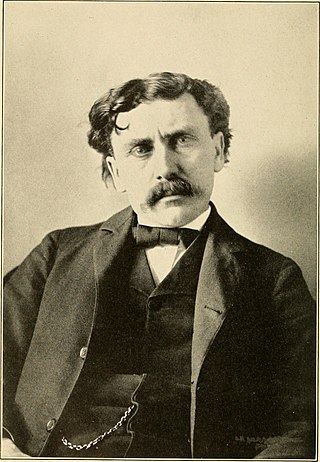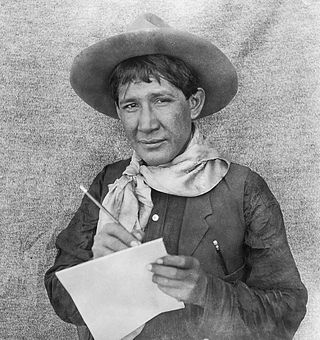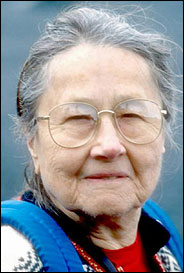Related Research Articles

James Mooney was an American ethnographer who lived for several years among the Cherokee. Known as "The Indian Man", he conducted major studies of Southeastern Indians, as well as of tribes on the Great Plains. He did ethnographic studies of the Ghost Dance, a spiritual movement among various Native American culture groups, after Sitting Bull's death in 1890. His works on the Cherokee include The Sacred Formulas of the Cherokees (1891), and Myths of the Cherokee (1900). All were published by the US Bureau of American Ethnology, within the Smithsonian Institution.

John Wesley Powell was an American geologist, U.S. Army soldier, explorer of the American West, professor at Illinois Wesleyan University, and director of major scientific and cultural institutions. He is famous for his 1869 geographic expedition, a three-month river trip down the Green and Colorado rivers, including the first official U.S. government-sponsored passage through the Grand Canyon.

George Catlin was an American lawyer, painter, author, and traveler, who specialized in portraits of Native Americans in the American frontier. Traveling to the American West five times during the 1830s, Catlin wrote about and painted portraits that depicted the life of the Plains Indians. His early work included engravings, drawn from nature, of sites along the route of the Erie Canal in New York State. Several of his renderings were published in one of the first printed books to use lithography, Cadwallader D. Colden's Memoir, Prepared at the Request of a Committee of the Common Council of the City of New York, and Presented to the Mayor of the City, at the Celebration of the Completion of the New York Canals, published in 1825, with early images of the City of Buffalo.

Museology is the study of museums. It explores the history of museums and their role in society, as well as the activities they engage in, including curating, preservation, public programming, and education.

Etowah Indian Mounds (9BR1) are a 54-acre (220,000 m2) archaeological site in Bartow County, Georgia, south of Cartersville. Built and occupied in three phases, from 1000–1550 CE, the prehistoric site is located on the north shore of the Etowah River.

The Bureau of American Ethnology was established in 1879 by an act of Congress for the purpose of transferring archives, records and materials relating to the Indians of North America from the Department of the Interior to the Smithsonian Institution. But from the start, the bureau's visionary founding director, John Wesley Powell, promoted a broader mission: "to organize anthropologic research in America." Under Powell, the bureau organized research-intensive multi-year projects; sponsored ethnographic, archaeological and linguistic field research; initiated publications series ; and promoted the fledgling discipline of anthropology. It prepared exhibits for expositions and collected anthropological artifacts for the Smithsonian United States National Museum. In addition, the BAE was the official repository of documents concerning American Indians collected by the various US geological surveys, especially the Geographical and Geological Survey of the Rocky Mountain Region and the Geological Survey of the Territories. It developed a manuscript repository, library and illustrations section that included photographic work and the collection of photographs.

William Henry Holmes, known as W. H. Holmes, was an American explorer, anthropologist, archaeologist, artist, scientific illustrator, cartographer, mountain climber, geologist and museum curator and director.

Alice Cunningham Fletcher was an American ethnologist, anthropologist, and social scientist who studied and documented Native American culture.
David Hurst Thomas is the curator of North American Archaeology in the Division of Anthropology at the American Museum of Natural History and a professor at Richard Gilder Graduate School. He was previously a chairman of the American Museum of Natural History's Anthropology Division.
Robert Hale Ives Goddard III is a linguist and a curator emeritus in the Department of Anthropology of the National Museum of Natural History at the Smithsonian Institution. He is widely considered the leading expert on the Algonquian languages and the larger Algic language family.
The Taensa were a Native American people whose settlements at the time of European contact in the late 17th century were located in present-day Tensas Parish, Louisiana. The meaning of the name, which has the further spelling variants of Taenso, Tinsas, Tenza or Tinza, Tahensa or Takensa, and Tenisaw, is unknown. It is believed to be an autonym. The Taensa should not be confused with the Avoyel, known by the French as the petits Taensas, who were mentioned in writings by explorer Pierre Le Moyne d'Iberville in 1699. The Taensa are more closely related to the Natchez people and both are considered descendants of the late prehistoric Plaquemine culture.
William Curtis Sturtevant was an anthropologist and ethnologist. He is best known as the general editor of the 20-volume Handbook of North American Indians. Renowned anthropologist Claude Lévi-Strauss described the work as "an absolutely indispensable tool that should be found on the shelves of all libraries, public and private alike."

James Alexander Teit was an anthropologist, photographer and guide who worked with Franz Boas to study Interior Salish First Nations peoples in the late 19th and early 20th centuries. He led expeditions throughout British Columbia and made many contributions towards native ethnology. He also worked with Edward Sapir of the Geological Survey of Canada in 1911.
Gerald F. Schroedl is a professor of anthropology at the University of Tennessee. He specializes in Southeastern United States and Caribbean prehistoric and historic archaeological sites. He is an authority on Cherokee prehistory and the archaeology of eastern Tennessee and western North Carolina.
Jason Baird Jackson is an American anthropologist who is Professor of Folklore and Anthropology at Indiana University Bloomington. He is "an advocate of open access issues and works for scholarly communications and scholarly publishing projects." At IUB, he has served as Chair of the Department of Folklore and Ethnomusicology and as Director of the Folklore Institute. According to the Journal of American Folklore, "Jason Baird Jackson establishes himself as one of the foremost scholars in American Indian studies today."
Daniel C. Swan is an American cultural anthropologist and museum curator whose work has focused on documenting and interpreting the cultural history of the Americas. He has specialized particularly on the histories, social organizations, and cultures of Native North American peoples in Oklahoma, USA. His research on the history, significance, and artistic forms of the Native American Church has led to research and exhibition collaborations with artists and elders in a diversity of American Indian communities, both in Oklahoma and elsewhere in the Western United States. In addition to his work on American Indian topics, he has organized exhibitions and museum catalogs about cultural diversity in the American West and in the Western Hemisphere more broadly.

Earnest Spybuck was an Absentee Shawnee Native American artist, who was born on the land allotted the Shawnee Indians in Indian Territory and what was to later become Pottawatomie County, Oklahoma, near the town of Tecumseh. M. R. Harrington, an archaeologist/anthropologist, was touring the area documenting Native Americans, their history, culture and living habits. Interested in the religious ceremonies of the Shawnee which included the use of peyote, Harrington had ventured to the Shawnee Tribal lands. There he learned of Earnest Spybuck's artistic work and encouraged Spybuck in his endeavors. While Spybuck's work was obviously art, Harrington saw that he was illustrating detailed scenes of ceremonies, games, and social gatherings which could be used to illustrate many anthropological publications. Spybuck's work was received positively by both Native American and non-native artistic communities. Many of his works are now held by the Smithsonian's National Museum of the American Indian.
John Daniel Rogers is an American archaeologist who is Curator of Archaeology in the Department of Anthropology at the National Museum of Natural History (NMNH) at the Smithsonian Institution in Washington, DC. He is well known for his archaeological work with the Spiro Mounds in Oklahoma and other sites in the southeastern United States, and has studied the rise of chiefdoms and empires across the world.

Frederica ("Freddy") Annis Lopez de Leo de Laguna was an American ethnologist, anthropologist, and archaeologist influential for her work on Paleoindian and Alaska Native art and archaeology in the American northwest and Alaska.
Ruth O. Selig is an American anthropologist, educator, and museum administrator known for her work advancing the incorporation of anthropology in precollege education, through teacher training programs, publications designed for high school and undergraduate instructors and students, and the Smithsonian Institution’s Department of Anthropology’s enhanced role in public outreach and education.
References
- ↑ "Department of Anthropology Staff". Smithsonian's National Museum of Natural History. Retrieved April 11, 2017.
- ↑ Rogers, Daniel Rogers (November 30, 1995). Mississippian Communities and Households. University of Alabama Press. p. xi. ISBN 9780817307684.
- ↑ Government Printing Office. Handbook of North American Indians, V. 12, Plateau. p. xv.
- ↑ Selig, Ruth (July 9, 2013). Anthropology Explored, Second Edition. Smithsonian Institution. ISBN 9781588343383.
- ↑ "Artists at Work 2017". E-Torch. February 10, 2017. Retrieved April 11, 2017.